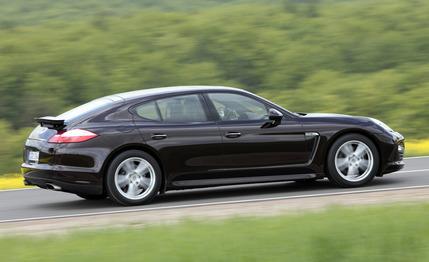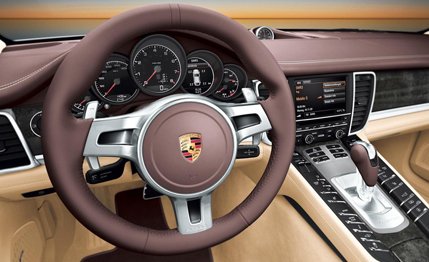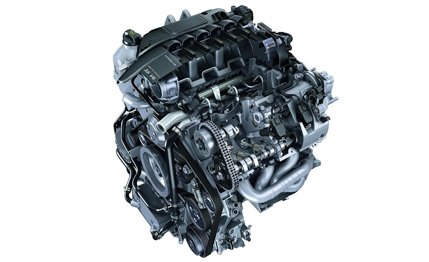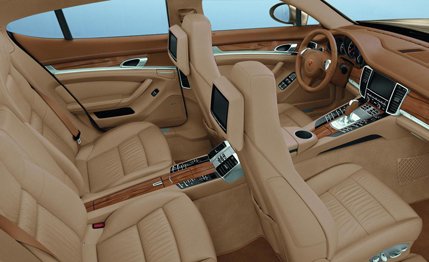
 First Drive Review
First Drive Review
So far, Porsche’s entry into the luxury-sedan segment has paid off. Sales of its Panamera are strong, and the company is particularly pleased by the take rate of the Turbo model, which it says is far higher than expected. This should fill the competition with envy, as the most powerful versions of the Audi A8, BMW 7-series, and Mercedes S-class are virtually salesproof in Europe and certainly far from volume models over here.


Now Porsche is lowering the barrier into Panamera ownership by some $15,000 with a 300-hp V-6–powered model. The engine is not a variation of Volkswagen’s VR6, which powers the entry-level Cayenne, but instead is a genuine Porsche powerplant, Zuffenhausen-built and created (essentially) by chopping two cylinders off the Panamera S’s 400-hp, 4.8-liter V-8. The cylinders of the new V-6 are arranged at a less than fully balanced 90 degrees, and Porsche uses a balance shaft to smooth operation. But it has all the V-8’s ingredients, including four overhead camshafts, variable intake valves, and direct injection.
That sounds like a good start, but we wondered if 295 lb-ft of torque and 300 hp would cut it in a 4000-pound sedan. We can confidently answer in the affirmative. The performance is good. Porsche claims the rear-wheel-drive base car can complete the 0-to-62-mph task in 6.1 seconds and that its top speed is an ungoverned 161 mph. At any point in the rev band, the V-6 is eager and responsive, and it remains strong into high triple-digit speeds—granted, a scenario you’re not likely to encounter on public U.S. roads. It’s true the entry-level Panamera doesn’t pack the fearsome power of the 500-hp Turbo, but if you look for enjoyment on the open road instead of dominating stoplight races, the V-6 is more than adequate. We were surprised at how much we liked this engine. There’s even a nice bellow when you fire it up, and the hoarse engine note, clearly audible throughout the rev band, is as appealing to our ears as is the V-8’s voluminous bass.


In the U.S., the Panamera comes only with the seven-speed dual-clutch transmission, a.k.a. Porsche-Doppelkupplungsgetriebe (PDK). The ZF-sourced unit provides quick and seamless shifts. To offset missing the torque multiplication of a conventional automatic transmission, the first gear is extremely short for quick takeoff. But when high-speed launches aren’t on the menu, simply ease into the throttle, and the PDK will still engage first but almost instantly perform a smooth and virtually unnoticeable upshift to second gear, all while the dash-mounted gear indicator reads “2.” It’s a parlor trick done for fuel economy’s sake. The PDK is occasionally slow to engage reverse, but altogether it represents the state of the art, and we’d take it over any conventional automatic. With the PDK, you can intervene manually any time by means of the awkward push/pull steering-wheel buttons integrated into the spokes of the standard steering wheel. Or upgrade to a wheel with much, much, much more satisfying paddle shifters, which is also available on Porsche’s sports cars and is yet another entry on the Panamera’s shockingly extensive and expensive options list.
No Manual, for Now
One item missing from that list, however, is Porsche’s smooth-shifting six-speed manual. Porsche North America didn’t ask for it; therefore, it isn’t available here. If customers insist, though, we’re told Porsche might change its mind. But the global take rate for the manual transmission is low. Five percent of rear-drive Panamera buyers—a manual is not available on all-wheel-drive cars, which includes the AWD-only Turbo—opt to shift for themselves full time.
The least-powerful Panamera also is the best-handling one, partly due to the fact that the V-6 is some 60 pounds lighter than the V-8, according to Porsche, removing some heft from the front of the car. The standard suspension is steel, and we’d describe it as dry and honest. The car’s full potential is unleashed by the optional Porsche Active Suspension Management (PASM) and air suspension, which allow you to switch the characteristics of the chassis among comfort, sport, and sport plus. Further adding Porsche Dynamic Chassis Control effectively eliminates body roll, and a torque-vectoring system makes the Panamera feel more agile via targeted braking on each rear wheel. With the full set of options, the Panamera feels as if it could drive circles around other luxury sedans. Turn-in is precise, although we think the speed-sensitive Servotronic steering should have more weight at lower velocities. But you always feel in control, and there is none of the artificial feel that can characterize the active steering in some Audi and BMW models.


As for the PASM settings, comfort delivers precisely what it says, as well as a bit of body roll but not excessive softness; most drivers could leave it here for good even during the occasional spirited run. Sport is the happy medium, stiffening responses without excessive harshness; even in this setting, passenger complaints should be limited to the crazy lateral g you’re pulling in the roundabout. Sport plus, on the other hand, is definitely on the wild side, although the Panamera’s version is a bit less extreme than is sport plus on various 911s. With a decidedly firm suspension setup and the extra jolt forward under load from late, ultra-quick PDK shifts, it’s clear sport plus means business.
The rear-wheel-drive Panamera stays neutral up to speeds where the competition simply can’t, and with a lenient stability-control setting selected, it’s easy to induce beautifully controllable oversteer. We wouldn’t recommend all-wheel drive unless you need your Panamera to negotiate long, hard winters; you could get a good set of winter tires for your rear-drive car. The Panamera 4 has a weight penalty of 120 or so pounds, and there are the inevitable parasitic power losses in the drivetrain. Really, if you’re not a speed junkie, the V-6 rear-driver may be the perfect Panamera.
Why Hybrid?
It doesn’t feel like it behind the wheel, but the Panamera is a big car, and it’s actually roomy enough to be chauffeured around in. (See the Chinese market for evidence of this.) The seating in the rear is deep and comfortable. We really like the dashboard and the interior. Instead of hidden functions as in BMW’s iDrive, Mercedes’ COMAND, and Audi’s MMI, the Panamera proudly parades its army of buttons, integrated into stylish center and roof consoles. If needed, you can fold the rear seats for more luggage room, and the hatchback offers additional practicality rare in most luxury sedans, much less in a Porsche car.
Porsche of course announced long, long ago that it would be introducing a hybrid version of the Panamera featuring a supercharged Audi engine teamed with an electric motor, but we doubt that package will be as agile and fun as this unexpectedly great, entry-level V-6 is. If you want an economical Panamera—the V-6 returns about 25 mpg in the European cycle—we say don’t wait.